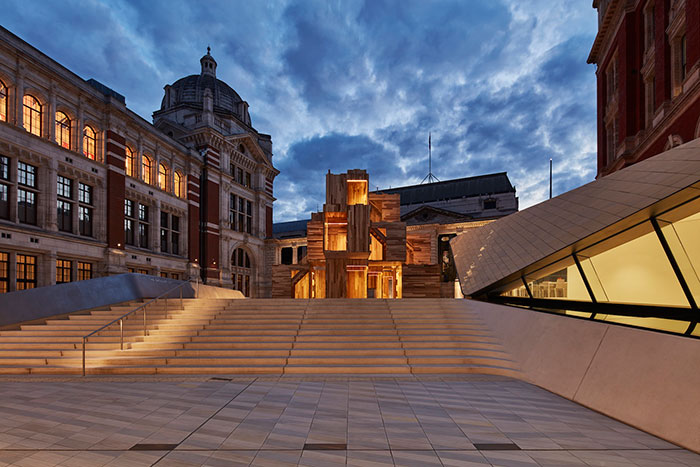A carbon-neutral American tulipwood pavilion launches at the London Design Festival
 Other News
Other News Subscribe to newsletter
Subscribe to newsletter
| 19 Sep 2018 |
MultiPly, a nine-meter high, carbon-neutral wooden pavilion made entirely of American tulipwood has opened to the public in the Sackler Courtyard of the V&A in time for the London Design Festival on September 15, 2018 and will remain there until October 1. The 43m3 of tulipwood that make up MultiPly store the equivalent of 30 tonnes of carbon dioxide and are replaced with natural growth in the American hardwood forest in just 5 minutes.

The installation is a collaboration between Waugh Thistleton Architects, the American Hardwood Export Council (AHEC) and ARUP, and illustrates how modular cross-laminated construction in hardwood is a viable solution to the current housing crisis. The structure is made with the first UK-manufactured cross laminated timber (CLT) panels. One of the London Design Festival’s Landmark projects, MultiPly is comprised of a maze-like series of interconnected spaces that overlap and intertwine. It has been conceived and constructed to encourage visitors to re-think the way we design and build our homes and cities.
The three-dimensional structure is built out of a flexible system, made of 17 modules of American tulipwood CLT, with digitally fabricated joints. Like a piece of flat-packed furniture, the pavilion arrived as a kit of parts and has quietly and efficiently been assembled in under a week. At the crown of the structure is a module with a thermo-treated tulipwood interior layer - the first time thermally modified timber (TMT) has been incorporated as a protective layer in CLT.
MultiPly confronts two of the current age’s biggest challenges - the pressing need for housing and the urgency to fight climate change and presents the fusion of modular systems and sustainable construction materials as a solution. Given that it is built out of modules, the pavilion can be taken apart and reassembled in a new home after the London Design Festival. “The main ambition of this project is to publicly debate how environmental challenges can be addressed through innovative, affordable construction,” says Andrew Waugh, Co-founder of Waugh Thistleton Architects, a studio that has been at the forefront of wood construction for decades. “We are at a crisis point in terms of both housing and CO2 emissions and we believe that building in a versatile, sustainable material, such as tulipwood, is an important way of addressing these issues.”
To keep up with population growth and deal with years of under supply, around 250,000 new homes would need to be built in the UK every year. In 2016/17, 184,000 new homes were built in the UK, a shortfall of approximately 66,000 homes. To increase supply to meet demand, we must change the way we think and build. Waugh Thistleton Architects have been pioneering innovative uses of wood in construction for decades. MultiPly explores a new, more sustainable way of building, bringing together a readily available carbon-negative material - American tulipwood - with modular design. AHEC have worked with many great architects - David Adjaye, Alex de Rijke, Alison Brooks, and now Waugh Thistleton - to demonstrate the structural, aesthetic and environmental properties of American tulipwood.
Tulipwood is sourced from the Eastern United States, where the hardwood forest area is expanding at a rate of one football pitch every minute, and already exceeds 110 million hectares, equivalent to the combined area of France and Spain. This makes the material both sustainable and environmentally friendly, especially as it is one of the most abundant American hardwoods. MultiPly uses a wood engineering technique known as cross-laminating, where timber planks are laid perpendicular to one another and glued together to form very strong, stiff and stable panels. CLT has traditionally been made of softwood trees. However, together with Arup, AHEC have been experimenting with CLT made from fast-grown U.S. tulipwood for the past decade.
The research and projects undertaken have proven that weight for weight, tulipwood CLT is stronger than steel and concrete and can be machined to incredibly high tolerances. This makes it ideal for prefabrication and rapid assembly, reducing construction times by around 30%. Tulipwood is an inexpensive and easy to machine hardwood that is incredibly strong for its weight.
The use of tulipwood CLT means that large-scale timber buildings can be constructed without the use of concrete or steel. These properties, together with its dramatic marble-like appearance, make tulipwood a perfect pioneer hardwood for innovative timber construction. Tulipwood planks are imported from the U.S., but the panels for MultiPly have been manufactured in the Construction Scotland Innovation Centre (CSIC), the UK’s first CLT factory.
MultiPly would not have been possible without the contribution of timber from AHEC members - Allegheny Wood Products, Baillie Lumber, Bingaman Lumber Inc., Boss Lumber Corporation, Classic American Hardwoods, Collins Hardwoods, Latham Timber, Northland Forest Products, Parton Lumber, and Thompson Hardwoods Inc. Tulipwood accounts for 7.7% of the total standing volume in U.S. hardwood forests. Every year, even after harvest, the volume of tulipwood in the U.S. forest grows by 19 million m3, the equivalent of over 19 Olympic swimming pools per day.




